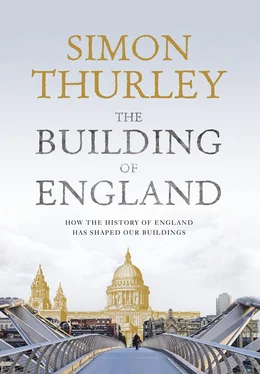Quarries were key to the building industry. Stone was not only extracted there, it was cut and carved. Blocks of ashlar, columns, bases and capitals were mass produced and shipped directly to the site, thereby avoiding the transport of stone that would end up as chippings at their destination. Working at a distance was, in principle, familiar, as the components of timber buildings were often cut remotely, transported and erected on site; but the precision needed for stonework was much greater. The dimension of each course of stone, for instance, had to accord with any decorative or structural elements in it. So ashlars had to be cut to different dimensions in the correct quantity. These details had to be carefully calculated and communicated to the quarry by means of written instructions and templates. The quarries therefore also became training schools, producing masons and carvers who could move to the great building sites, where they could learn to set stone and undertake some of the more exacting work that was done on the bench in masons’ lodges on site. 30
In Normandy as much as in England the quality of masonry improved markedly in the hundred years after the Conquest; larger blocks, tighter joints, finer carving suggest more skilled design, increasing proficiency among masons and better tools. It enabled the shift from the austerity of Winchester to the exuberance of Durham. Yet architecture after 1066 was as experimental as the Saxon work that preceded it. From 1000, people increasingly became used to seeing and experiencing stone buildings, but this should not obscure the fact that even after 1066 timber remained the most important and common building material. Although most churches were now built in stone, the first generation of castles – and almost all domestic, agricultural and industrial buildings – remained of timber. Stone buildings, too, contained huge quantities of timber; the earliest timber roof to survive intact is at St Mary’s, Kempley, Gloucestershire. It dates from soon after 1120 and comprises fifteen trusses, with sole-plates projecting into the church that were probably carved with animal heads. 31Other fragments of early timberwork survive, including the unusual and handsome nine-bay balustrade of c .1180 at St Nicholas’s, Compton, Surrey, and a door of c .1050 in Westminster Abbey. 32
The construction of the great Norman cathedrals was overseen by masons who we would today call architects. After 1066 their names are increasingly known: Blithere at Canterbury, Robert at St Albans and Hugh at Winchester. These men understood the principles of engineering, not through the written word, but through observation and trial and error. They drew plans, sections and templates either on parchment, wood or on large plaster panels. The earliest English architectural drawing to survive (of c .1200) is at Byland Abbey, Yorkshire, where incised drawings on a floor slab and a wall are full-size sections of the west front rose window. 33In addition to drawings, designers commissioned models and templates, either at reduced scale or sometimes full-size.
It has been said that by looking at buildings alone it would be impossible for a historian to guess that the Norman Conquest had taken place. In 1000 England’s architecture had already reached a turning point and the changes that came rapidly after 1066 had been in embryo since the 1050s at the latest. Yet without doubt the Conquest hugely accelerated architectural change. The building and craft industries quickly developed and diversified, and by 1130 almost everyone could experience stone architecture in their own locality. The great Saxon estates had been broken up and, as well as the great magnates, there was now a large class of middling landowners who aspired to build themselves homes and churches.
The severe unsullied monumentality of early Norman buildings as seen in the transepts of Winchester or the elevations of the White Tower lasted merely a generation; they soon gave way to something more florid and playful. Likewise the reforming aspirations of the Norman churchmen were diluted and what remained was an English compromise. As the first generation of Normans died out, England’s architecture was already looking very different to anything in their former homelands. Indeed, the men and their families were feeling different, too. They might not have been able to express it in 1130, but the Normans and their architecture were becoming English.
As the second generation of Normans felt more English, so the great cathedrals, abbeys, castles and houses then under construction became increasingly distinct from their counterparts in France.
The Normans and the English
Many thought the death of Henry I in 1135 a calamity. He was the Conqueror’s last surviving son and was outlived by only one legitimate child, Matilda. Matilda was his agreed successor but his nephew Stephen darted across the Channel and was crowned before he could be stopped. This led to a period of disorder and uncertainty, often called the Anarchy, which was only resolved by Stephen’s death and the accession of Matilda’s son, Henry II, in 1153.
Henry II had huge strength of character, boundless energy, and a determination to re-establish order and the rule of law. His court was cosmopolitan and, through his marriage to Eleanor of Aquitaine, he presided over territories from Scotland to the Pyrenees. Henry was not a Norman king; he had Anglo-Saxon ancestry through his mother, and of his eight great-grandparents only William the Conqueror was Norman. But it was not only the monarchy that was no longer Norman. Families whose ancestors had arrived with the Conqueror had begun to see themselves as English; while the first generation of newcomers had usually been buried in Normandy, by the 1150s their children and grandchildren were buried in England. 1
A sense of Englishness also becomes increasingly apparent in the work of a generation of historians writing between about 1120 and 1150. Henry of Huntingdon, for instance, set out to write the history of ‘this, the most celebrated of islands, formerly called Albion, later Britain, and now England’. His History of the English continued up to his own time and explained that the past victories of the Normans, including the Conquest of 1066, were now English history. This was in many respects true. The Norman ruling elite had married English women, adopted English laws and customs, assimilated native administrative structures, appropriated English history as their own and made pilgrimages to the shrines of Anglo-Saxon saints. In fact, although they didn’t speak English as their first language, the third generation of Normans were now Englishmen. 2
Despite Henry II’s strength and success, he, no more than William the Conqueror, could control events after his death, and his sons Richard and John frittered away the territories and powers amassed by their father. Yet in many senses the reigns of Henry’s sons saw a further reinforcement of English identity: King Richard’s absence in 1191; the loss of Normandy in 1204; the interdict of 1208 (when the pope banned the administration of the sacraments in England) and the failed invasion of England by Prince Louis of France in 1216 – all these led to increasing insularity and even xenophobia.
This reinforcement was of great importance for the development of English architecture in the century or so after 1130. The growing wealth, self-confidence and identity of the English ruling class led to an energetic patronage of architecture. Magnates reorganised their estates, built themselves castles, and endowed churches and monasteries; bishops reconstructed their cathedrals and abbots built new abbeys. The style in which these buildings were constructed was ambitious, original and, with hindsight, English. 3
Читать дальше












